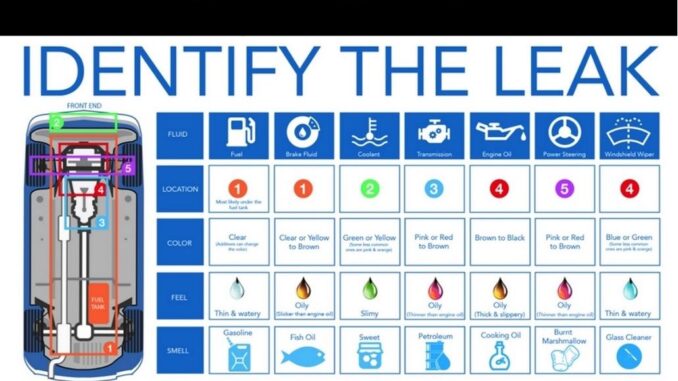
SO, SOONER OR LATER ANY CAR CAN DEVELOP A FLUID LEAK. AND, WHEN IT DOES, FINDING THE SOURCE OF THE LEAK, SHOULD BE YOUR FIRST PRIORITY.
Once you find the source of the leak, you on your way to knowing, what the fluid actually is. There are a number of different fluids and locations, that can develop leaks. Some are far more important than others, and can cause major damage.
So, the faster you can identify the fluid leak, the sooner you can save costly repairs.
Consequently, the odds are good that one day, you’re going to see something leaking from your car. And, when that happens, you’re probably going to worry about it. Above all, what the leaking fluid is, and what it means for your car. But, before you get too concerned, you should learn how to identify, the fluids in your car. Diagnosing leaks is really, not that hard.
CONSEQUENTLY, ANY OF THE FOLLOWING CAN LEAK:
- Brake fluid
- Engine Coolant
- Windshield washer fluid
- Engine Oil
- Water
- Power steering fluid
- Transmission fluid
SO, BEFORE YOU START WORRYING, TAKE A MOMENT TO LOOK AT THE FLUID:
- What color is it?
- Does it have a smell?
- Check the consistency.
HERE’S HOW TO IDENTIFY THE FLUID LEAK:
If it’s clear, watery, and under the air conditioner:
- It’s probably normal condensation, if you’ve used the air conditioner recently.
And, If it’s black or dark brown, greasy, and located under the engine area:
The fluid leak is probably engine oil. Figure out which part of the vehicle, was over the spot:
- Look around the oil filter
- The oil drain plug
- The crankcase
- And, the oil pan
If it’s thick, black or tan oily liquid:
- Gear oil may be leaking from a manual transmission, the differential, an axle, or the steering gears. As a result, any of these leaks, needs immediate attention.
And, if it’s red, pink, or reddish-brown and greasy and you have an automatic transmission:
- It’s probably a transmission fluid leak. Check the transmission dipstick, and if the level is low, top it off with the proper transmission fluid. Then, check the dipstick again in a day or two.
If it’s watery or slippery green, red, blue, or yellow and is coming from under the radiator or engine:
- It’s probably engine coolant. Check the radiator, pressure cap, engine, and hoses for leaks.
And, if it’s oily pink, red, or clear and you find it toward the front bumper (usually driver’s side):
- It’s probably power-steering fluid. Since the power-steering system is sealed and shouldn’t lose fluid.
If it’s a light-colored or clear fluid:
- It may be a brake fluid leak. Even if the leaks have dried, the stains should be visible. Leaky brakes are very dangerous. Above all, have a professional, repair any brake fluid leak immediately.
If it smells like rotten eggs:
- It could be battery acid. So, avoid getting it on your hands or clothes and have the battery replaced.
Finally, if it smells like fuel:
Most likely you have a fuel leak !
- Is the smell coming from under the hood. If so, check around the fuel pump and the fuel injectors – or the carburetor if your vehicle has one.
- When the leak seems to be under the center of the vehicle, check the fuel lines.
- Also, if it’s under the rear end, check the fuel tank.
(Don’t smoke while you do this!)
Now that you have identified what type of fluid is leaking, you can move on to the proper repair.
CONCLUSION
So, knowing how to identify a fluid leak, is an important skill for any car owner. Because, some fluid leaks can be fixed at home. But, others denote potentially serious problems and need to be checked by a professional. Finally, regularly check for possible fluid leaks, and be aware of any puddles around your normal parking spaces.
BY DANNY BENDER




